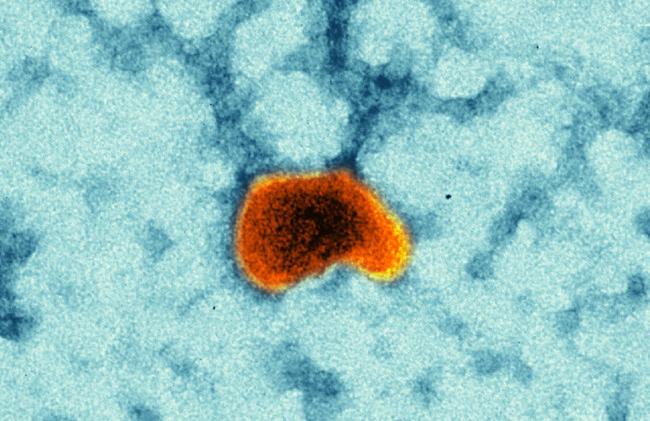Measles Virus Vaccination-based SARS-CoV-2 Vaccine induces Immune Response in Mice and Hamsters
As part of the research activities within the German Center for Infection Research (DZIF), scientists of the Paul-Ehrlich-Institut studied specific vaccine candidates against COVID-19. They are based on an attenuated and very well tolerable measles vaccine strain (vaccine vector). One variant showed good stability and triggered high antibody titers and good cellular T-cell immune response in mice and hamsters, accompanied by good efficacy against infection after prime-boost vaccination. This supports the further development of COVID-19 vaccines on the basis of the attenuated measles vaccine (PNAS online, 30.11.2020).

Significant efforts are being made world-wide to study vaccines against COVID-19. Meanwhile, several vaccine candidates are undergoing Phase 3 clinical trials. Researchers of the Paul-Ehrlich-Institut in the team of PD Dr Michael Mühlebach, head of the research group Oncolytic Measles Viruses and Vaccine Vectors and head of section Product Testing of Immunological Medicines for Veterinary Use have been studying vaccines based on innocuous, attenuated measles vaccine viruses as a model system for modern vector vaccines for several years. Part of this research is done within the research activities in the German Center for Infection Research (Deutsches Zentrum für Infektionsforschung, DZIF).
The measles vaccine viruses serve as a vector. They are used as a transport vehicle for parts of the genetic information of a different pathogen in order to present selected antigens in only few body cells of the immune system, thus building up tailored immune protection. To achieve this, the genetic information of the antigen is inserted into the genome of the measles vaccine virus. This vector vaccine thus resembles a vaccine platform approach. Like in a construction kit, the appropriate genetic information of choice, which is integrated into the vaccine virus, just depends on the pathogen against which a protective immune response is to be achieved.
Currently, the research team has studied the suitability of this platform as the basis for vaccine candidates against SARS (severe acute respiratory syndrome) Coronavirus-2, SARS-CoV-2. They inserted the genetic information of the SARS-CoV-2 spike glycoprotein (S), an antigen of SARS-CoV-2, into the measles vaccine virus. This antigen is the target structure of the neutralising antibody response. The genetic information of the S-protein gene was integrated in the genome of the measles virus at either one of two different genomic positions in its full length. One of the two variants has proved to be stable over extended passaging. After mice and golden hamsters were vaccinated, the vaccination induced the generation of antibodies comparable with that of infected persons who subsequently recovered, and triggered a potent and broad cellular immune response. These immune responses reduced the viral load in immunised animals in the upper and lower airways by at least 90 percent. Infected naive or vaccinated mice did not develop any recognisable COVID-19 disease symptoms so that the vaccine efficacy was determined via the reduction of the virus load. Vaccinated Syrian golden hamsters were protected by the vaccination of a severe course of the symptomatic infection.
In addition, the immune response showed a bias in the direction of the so-called Th1 type. It is not only the good and efficacious immune response altogether which makes the measles vaccination virus platform attractive for the development of safe and efficacious COVID-19 vaccines but also this bias in the direction of the desired Th1 sub-type. A favourable concomitant effect is that immune responses were not only induced against SARS-CoV-2 but also against measles virus. These data thus point to the fact that this vaccine could be used to infer protection by vaccination against both COVID-19 and against the measles. Especially in countries which had to discontinue routine vaccination campaigns in view of the COVID-19 pandemic, such a vaccine could be an advantage to prevent the risk of a renewed increase in measles infections. The measles continue to present a major problem world-wide: The number of deaths caused by the measles has increased by 50 percent between 2016 and 2019, as the World Health Organisation (WHO reported in November 2020 .
“Results obtained up to now speak in favour of a good suitability of the measles vaccine virus platform technology for developing efficacious vaccines for simultaneous protection against COVID-19 and the measles. Besides, against the background of decades of experience with the measles, we are optimistic in view of the safety and tolerability of these vaccines,”
as PD Dr Michael Mühlebach explains the meaning of the results.
With its research activities, the Paul-Ehrlich-Institut, Federal Institute for Vaccines and Biomedicines also contributes to the study of effective and safe COVID-19 vaccines. Based on its mandate in regulatory affairs, however, it does not develop vaccine products. Its regulatory duties include the authorisation of clinical trials and the marketing authorisation of vaccines in Germany, the risk/benefit assessment as part of centralised marketing authorisation procedures at the European Medicines Agency and batch control testing and release. Vaccines can only be marketed in Germany after they have received a marketing authorisation and batch release from the Paul-Ehrlich-Institut.
Original Publication
Hörner C, Schürmann C, Auste A, Ebenig A, Muraleedharan S, Dinnon KH, Scholz T, Herrmann M, Schnierle B, Baric RS, Mühlebach MD (2020): A Highly Immunogenic Measles Virus-based Th1-biased COVID-19 Vaccine.
Proc Natl Acad Sci USA 117: 32657-32666.
Text
top



